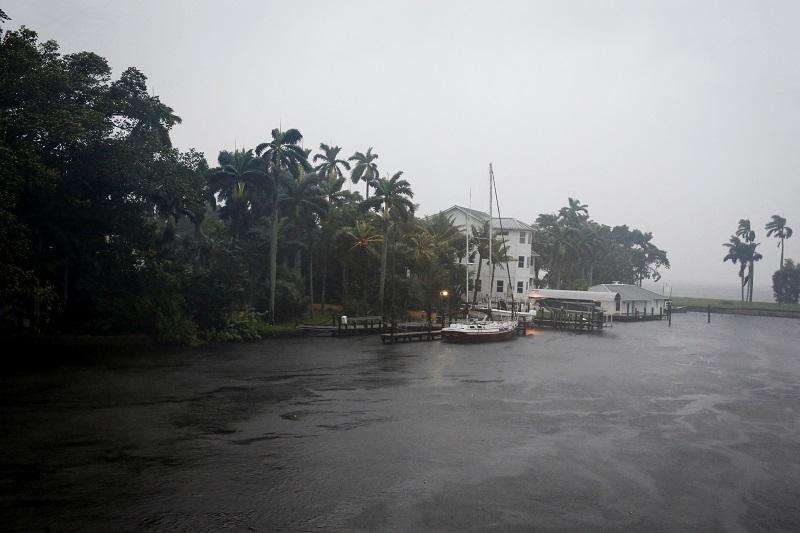Hurricane Ian makes landfall in Florida with Category 4 fury

VENICE, Florida - Hurricane Ian plowed into Florida's Gulf Coast with catastrophic force on Wednesday, assaulting the state with howling winds, torrential rain and a treacherous surge of ocean surf that made it one of the most powerful storms on record to hit the United States.
Ian made landfall in Cayo Costa as a Category 4 hurricane, with sustained winds of up to 150 miles per hour (241 km per hour), the US National Hurricane Center (NHC) reported.
The storm's wind speeds put it just shy of a Category 5 designation on the Saffir-Simpson scale, the most severe classification for storms with maximum sustained winds of at least 157 mph, though Ian was expected to weaken a notch after coming ashore, according to the NHC.
The landfall zone is home to miles of sandy beaches, scores of resort hotels and numerous mobile home parks, a favorite with retirees and vacationers alike.
Even as Ian lashed Florida's Gulf Coast with fierce winds and drenching rains in the final hours before it swept ashore, authorities put residents on notice than it was too late for anyone who had yet to evacuate to safely do so.
In Venice, a coastal city of nearly 24,000 residents halfway between Tampa and Fort Myers, rain and wind were already intense before noon. Many streets were flooded, and the steady gale bent palm trees at 45 degree angles and shredded billboards and road signs.
Forecasters say Ian would unleash storm surges - wind-driven coastal flooding - of up to 18 feet (3.7 meters) along with intense thunderstorms and possible tornadoes.
"This is a storm that we will talk about for many years to come, an historic event," said Ken Graham, director of the National Weather Service.
More than 524,000 homes and businesses were without power in Florida on Wednesday afternoon, according to local utilities In total, Ian has affected more than 830,000 customers so far, but power companies have restored some early outages.
Earlier this week, authorities told more than 2.5 million residents to evacuate. Doug Coe of Venice was one of those residents who chose to ignore warnings and stay put. As he walked through rainfall on Wednesday morning to see how a friend's home was weathering the storm, Coe admitted to never experiencing a storm of this magnitude, but he was unfazed by the prospects of it ravaging his neighborhood.
“You have to be vigilant because you never know what’s going to happen with it,” he said. “I’m staying vigilant, but trying not to worry.”
Hotels along Interstate Highway 75, which runs up and down Florida’s west coast, were jam packed with people seeking shelter. The area is dotted with mobile home parks, which most residents had abandoned, taking refuge in local schools and other facilities being used as emergency shelters. The area's numerous assisted-living facilities were mostly evacuated, too.
Heartis Venice, an assisted living home north of Venice, was an exception. Of its 107 residents, 98 decided to shelter in place and continue receiving care with help of staff and some family members, general manager Michelle Barger said. The facility, opened two years ago, was built to withstand a Category 5 storm.
The facility stocked up on enough food and water to last more than seven days, as well as all medications and supplies needed to provide services, Barger said.
"Our community is locked down. We're secure and we're prepared for this," she said. "We feel pretty confident and safe, as do the residents and families and team members here."
Warming planet
Climate change is making hurricanes wetter, windier and more intense. There is also evidence that it is causing storms to travel more slowly, meaning they can dump more water in one place, scientists say.
"Hurricane Ian's rapid intensification could prove to be another example of how a warming planet is changing hurricanes," said Kait Parker, meteorologist and climate scientist at IBM's weather.com. "Research shows we are seeing this far more often than we did in decades past."
Overnight and into Wednesday morning, Hurricane Ian pounded the Florida Keys island chain to the south with heavy rains showers and winds gusts of 40 mph, the NWS reported.
On Tuesday, the storm thrashed Cuba, knocking out the electrical grid for 11 million people and ravaging the western end of the island with violent winds and flooding. By early Wednesday, the state electricity provider said it had begun to restore power across the eastern end of the island. -- Reuters





